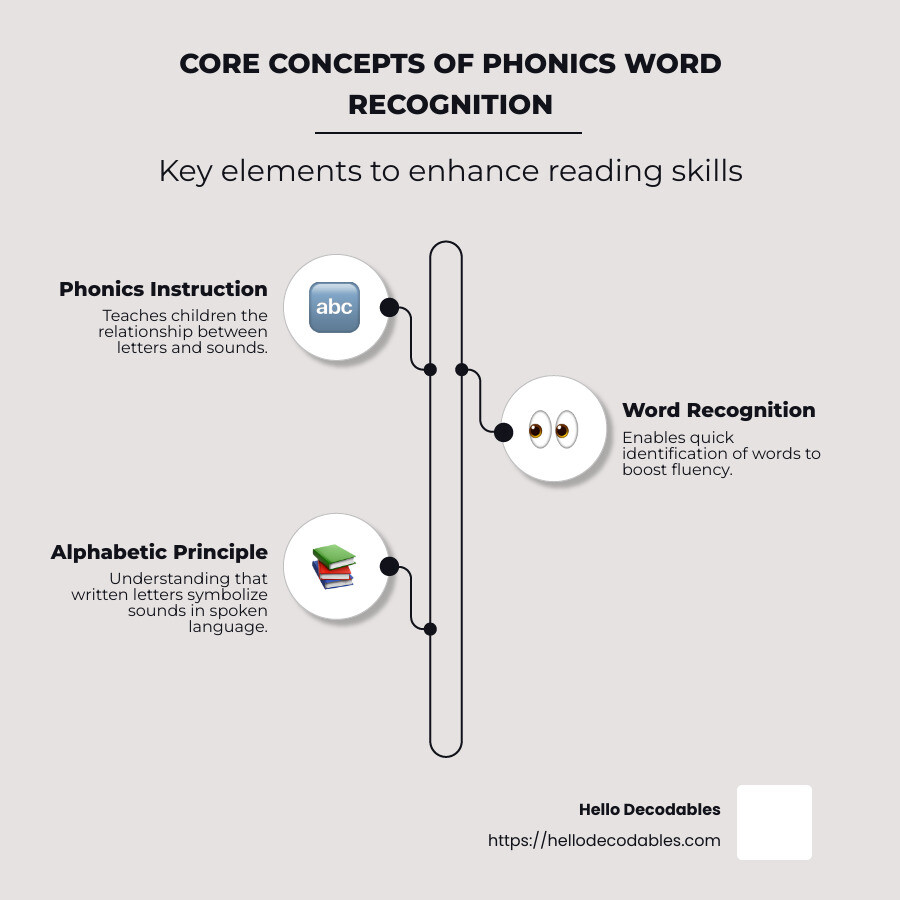
· By Jen Jones
Phonics Power: Building Strong Word Recognition Skills
Phonics word recognition is a key component in helping young children develop strong reading skills. This essential reading technique emphasizes connecting letters to sounds to form words, making reading more accessible and engaging for early learners.
At the heart of phonics word recognition is the alphabetic principle, the understanding that written letters symbolize the sounds of spoken language. This insight is crucial for children as they learn to decode words and recognize them by sight, leading to greater reading fluency and comprehension. For parents searching for phonics-based tools to assist their children, a structured approach focusing on sound-symbol relationships is beneficial. Here's what you need to know:
- Phonics Instruction: It helps children map the relationship between letters and sounds.
- Word Recognition: This skill enables children to identify words quickly, improving reading fluency.
- Alphabetic Principle: Understanding this helps children grasp how words are constructed and pronounced.
I'm Jen Jones, an educator and literacy expert with over 30 years dedicated to advancing phonics word recognition. As the founder of Hello Literacy, I specialize in creating engaging literacy solutions that support young readers in understanding the intricate yet teachable concepts of reading. Let's dig into phonics and how it can transform your child's reading journey.

Understanding Phonics and Word Recognition
Phonics recognition is the foundation of learning to read. It involves understanding the connection between letters and sounds, which is crucial for decoding words. This process helps children break down words into their individual sounds, or phonemes, and then blend them back together to form words.
Decoding: The Key to Reading
Decoding is a critical skill in reading. It enables children to interpret written language by translating letters into sounds and then blending those sounds to form words. Think of decoding as the bridge between seeing a word and understanding it. When a child sees the word "cat," they use their knowledge of letter-sound relationships to sound it out: /k/ /a/ /t/. This skill is vital for reading unfamiliar words and is a significant step toward reading fluency.
Letter-Sound Relationships
Understanding letter-sound relationships is like having a secret code to open up reading. Each letter or group of letters represents a specific sound. For example, the letter "m" makes the /m/ sound, and the letters "sh" together make the /sh/ sound. By mastering these relationships, children can decode new words they encounter, making reading less daunting and more enjoyable.
The Impact of Phonics Recognition
- Improved Reading Fluency: As children become proficient in decoding, they read more fluently, allowing them to focus on understanding the text rather than struggling with each word.
- Improved Comprehension: With automatic word recognition, children can concentrate on the meaning of the text, improving their overall comprehension.
- Increased Confidence: When children can decode and recognize words quickly, they gain confidence in their reading abilities, which encourages a love for reading.

Phonics and word recognition are not just about learning to read; they are about building a strong foundation for lifelong literacy. By understanding the mechanics of how words are formed and pronounced, children can start on a reading journey that is both rewarding and enriching. This journey begins with recognizing the simple yet powerful connection between letters and sounds.
Strategies for Effective Phonics Instruction
When it comes to teaching children how to read, systematic phonics instruction is a game-changer. It involves teaching letter-sound relationships in a well-organized, logical sequence. This method ensures that children are not overwhelmed and can build on what they have already learned. By introducing new material in small, manageable units, students can absorb information more effectively and make meaningful progress.
Systematic Phonics: Building a Strong Foundation
Systematic phonics instruction is like constructing a building. You start with a strong foundation and add layers progressively. Each lesson builds on the last, reinforcing previous skills while introducing new ones. This approach not only helps children make sense of the complex English language but also identifies gaps in their learning, ensuring no child is left behind.
Explicit Instruction: Clarity is Key
Explicit instruction is all about clarity and direct teaching. Teachers clearly explain phonics concepts and skills, making sure students understand before moving on. Children are not left to infer or guess these concepts from exposure alone. This direct approach has been shown to produce better readers and spellers, as children understand exactly what is expected of them.
Teaching to Mastery: Ensuring Success
Teaching to mastery ensures that students fully understand and can apply what they've learned before moving on to new material. This method is highly motivating for children. When they master a skill, they feel successful and confident, which boosts their self-esteem.

Why is this approach so effective? Because students who have truly mastered a lesson can easily learn new material. They're building a strong foundation for future learning, which is crucial for developing fluent and confident readers.
The Impact of Effective Phonics Instruction
- Improved Reading Achievement: Systematic and explicit phonics instruction significantly improves children's reading comprehension and fluency.
- Increased Confidence: As children master phonics skills, they gain confidence in their reading abilities, fostering a love for reading.
- Prevention of Reading Difficulties: Early phonics instruction can prevent reading difficulties, especially for at-risk students, and help struggling readers overcome challenges.
In summary, effective phonics instruction is not just about teaching children to read words; it's about equipping them with the skills they need to become proficient and confident readers. By using systematic, explicit instruction and focusing on teaching to mastery, educators can ensure every child has the opportunity to succeed in their reading journey.
Phonics Word Recognition Techniques
Phonics word recognition is a cornerstone of early reading success. Let's explore some key techniques that help children become proficient readers.
Blending and Segmenting
Blending and segmenting are essential skills in phonics instruction. Blending involves smoothly combining individual sounds to form words. For instance, when children learn to blend the sounds /c/, /a/, /t/, they can read the word "cat." This skill is crucial for decoding unfamiliar words and is often taught through fun activities like sound games and word puzzles.
Segmenting, on the other hand, is the process of breaking down words into their individual sounds. For example, the word "dog" can be segmented into /d/, /o/, /g/. This technique helps children understand the structure of words and improves their spelling abilities.
Sound-to-Print Associations
Understanding sound-to-print associations is another vital aspect of phonics word recognition. This means recognizing that specific sounds correspond to specific letters or letter combinations. For example, the sound /f/ can be represented by the letter "f" in words like "fish."
Research shows that explicit teaching of these associations is beneficial. Children learn more effectively when teachers provide clear examples and practice opportunities. Using visual aids like letter tiles or flashcards can make this process engaging and memorable for young learners.
Word Families
Word families are groups of words that share common patterns. These patterns make it easier for children to recognize and decode words. For instance, the "-at" family includes words like "cat," "bat," and "hat." By learning one pattern, children can read multiple words, boosting their confidence and reading speed.
Engaging activities like word family charts and rhyming games can reinforce these patterns. This technique not only improves word recognition but also helps children understand the predictable nature of English spelling.
The Power of Phonics Word Recognition
- Improved Reading Skills: By mastering blending, segmenting, and sound-to-print associations, children become skilled at recognizing and reading words.
- Increased Vocabulary: Word families expand children's vocabulary, enabling them to read and understand more complex texts.
- Boosted Confidence: As children recognize more words, their reading fluency and confidence grow, encouraging a lifelong love of reading.
By incorporating these techniques into phonics instruction, educators can provide children with the tools they need to succeed in reading. These foundational skills pave the way for improved comprehension and a deeper understanding of language.
The Role of Phonics in Reading Comprehension
Phonics plays a crucial role in developing reading comprehension, fluency, and spelling skills. These components are interconnected, each supporting the other to build a strong foundation for reading success.
Text Comprehension
Text comprehension is the ultimate goal of reading. It's about understanding, interpreting, and gaining meaning from text. Phonics instruction aids comprehension by enabling children to decode words independently. When students can efficiently decode words, they can focus more on understanding the text's meaning rather than getting stuck on individual words.
For instance, when children learn phonics, they can quickly recognize and read words like "cat," "bat," and "hat" without having to stop and sound them out each time. This automaticity frees up cognitive resources, allowing them to concentrate on the narrative or information presented.
Fluency
Fluency is the ability to read with speed, accuracy, and proper expression. It acts as a bridge between word recognition and comprehension. Fluent readers recognize words effortlessly and read aloud smoothly. This fluency comes from the practice of phonics word recognition, where students repeatedly decode and blend sounds to form words.
A study highlighted in the research shows that students who practice phonics regularly exhibit improved oral reading fluency (ORF). In grades 4-6, more than 20% of students not practicing phonics fall below the ORF benchmark. This statistic underscores the importance of continued phonics practice beyond the early grades to maintain reading proficiency.
Spelling
Spelling is intrinsically linked to phonics. Understanding the relationship between sounds and letters helps children spell words correctly. Phonics instruction teaches students to break down words into phonemes, the smallest units of sound, and map these sounds to letters or letter combinations.
For example, knowing that the sound /f/ can be represented by "f" in "fish" or "ph" in "phone" improves both spelling accuracy and phonics word recognition. This understanding also helps children recognize and apply spelling patterns, which are critical for writing and reading more complex words.
In summary, phonics instruction is essential not only for decoding and word recognition but also for fostering reading comprehension, fluency, and spelling. These skills are interdependent, and together, they empower students to become proficient, confident readers.
Frequently Asked Questions about Phonics Word Recognition
How do you identify phonics words?
Identifying phonics words involves recognizing the connection between sounds and letters. This process is called blending and segmenting.
- Blending is when you combine individual sounds to form a word. For instance, the sounds /c/, /a/, and /t/ are blended to make "cat."
- Segmenting is the reverse process. It involves breaking a word into its individual sounds. For example, segmenting "dog" would result in the sounds /d/, /o/, and /g/.
Sound recognition is key here. It allows students to hear and identify the distinct sounds in words, which is the foundation for blending and segmenting.
What are the strategies of phonics and word recognition?
Phonic recognition, decoding, and analogizing are essential strategies in phonics and word recognition.
- Phonic recognition involves matching letters to their corresponding sounds. This is crucial for reading and spelling new words.
- Decoding is the ability to apply knowledge of letter-sound relationships to correctly pronounce written words. Research shows that systematic and explicit phonics instruction significantly improves decoding skills.
- Analogizing is using known word patterns to read unfamiliar words. For example, if a student knows how to read "cake," they can use that pattern to read "bake" or "lake."
These strategies help students become more proficient in reading by allowing them to approach new words with confidence.
What is phonics recognition?
Phonics recognition is the process of understanding the relationships between letters and sounds, which is fundamental for decoding and blending.
- Letter-sound matching is the core of phonics recognition. It involves knowing which letters represent which sounds and how these sounds form words.
- Decoding and blending are part of this process. Decoding is translating written words into their spoken equivalents, while blending is combining sounds to form words.
Phonics recognition is about making connections between letters and sounds to read words accurately and fluently.
By mastering these skills, students are better equipped to tackle more complex texts and improve their overall reading abilities.
Conclusion
At Hello Decodables, we believe that phonics word recognition is the cornerstone of reading success. Our mission is to empower children to become confident readers through our structured, systematic approach to phonics instruction. This method aligns with the Science of Reading research, ensuring that every child has the tools they need to decode words effectively and enjoy reading.
Our decodable books are designed to reinforce phonics skills in a practical and engaging way. By focusing on blending and segmenting, sound-to-print associations, and word families, we help children develop a robust foundation in reading. Our books provide ample opportunities for students to practice new phonics skills while revisiting previously learned ones, allowing for continuous growth and mastery.
In the field of educational publishing, Hello Decodables stands out by offering resources that are not only educational but also enjoyable. We understand that reading is not just about recognizing words—it's about understanding and finding joy in the text. Our books are crafted to make learning to read an exciting trip, filled with stories that are both decodable and engaging.
By choosing Hello Decodables, educators and parents can be confident that they are providing children with a strong start in their reading journey. Our commitment to phonics success ensures that students are not only learning to read but are open uping a lifetime of knowledge and pleasure.
For more on how we engage early readers with phonemic awareness, visit our Engaging Phonemic Awareness Activities for Early Readers page. Let's work together to build a future where every child can read confidently and fluently.
